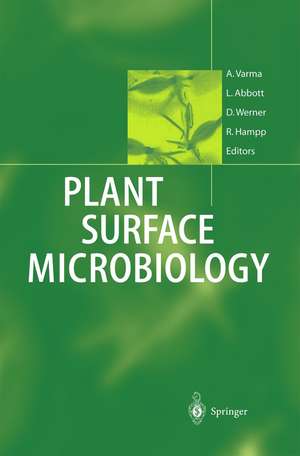Plant Surface Microbiology
Editat de Ajit Varma, Lynette Abbott, Dietrich Werner, Rüdiger Hamppen Limba Engleză Hardback – 24 mar 2004
Interactions between plants and microorganisms are often located on plant surfaces, such as leaf cuticles, seeds and mainly on the roots. The communication between plants and microbes is the main topic treated in "Plant Surface Microbiology", such as the signaling within a symbiosis, the molecular differences between symbiotic and pathogenic microorganisms, the role of microorganisms in the development of plants or in plant protection against deleterious agents. Further contributions are devoted to: the analysis of bacterial communities in the rhizosphere; microbial population genetics; aspects of mycorrhizal symbiosis; functional genomic approaches and the use of microorganisms as bio-indicator of soil disturbance.
| Toate formatele și edițiile | Preț | Express |
|---|---|---|
| Paperback (1) | 1234.14 lei 6-8 săpt. | |
| Springer Berlin, Heidelberg – 10 oct 2007 | 1234.14 lei 6-8 săpt. | |
| Hardback (1) | 1240.47 lei 6-8 săpt. | |
| Springer Berlin, Heidelberg – 24 mar 2004 | 1240.47 lei 6-8 săpt. |
Preț: 1240.47 lei
Preț vechi: 1512.77 lei
-18% Nou
Puncte Express: 1861
Preț estimativ în valută:
237.36€ • 248.49$ • 196.40£
237.36€ • 248.49$ • 196.40£
Carte tipărită la comandă
Livrare economică 05-19 aprilie
Preluare comenzi: 021 569.72.76
Specificații
ISBN-13: 9783540009238
ISBN-10: 354000923X
Pagini: 664
Ilustrații: XXXI, 632 p.
Dimensiuni: 156 x 234 x 41 mm
Greutate: 1.1 kg
Ediția:2004
Editura: Springer Berlin, Heidelberg
Colecția Springer
Locul publicării:Berlin, Heidelberg, Germany
ISBN-10: 354000923X
Pagini: 664
Ilustrații: XXXI, 632 p.
Dimensiuni: 156 x 234 x 41 mm
Greutate: 1.1 kg
Ediția:2004
Editura: Springer Berlin, Heidelberg
Colecția Springer
Locul publicării:Berlin, Heidelberg, Germany
Public țintă
ResearchCuprins
Section A.- The State of the Art.- Root Colonisation Following Seed Inoculation.- Methanogenic Microbial Communities Associated with Aquatic Plants.- Role of Functional Groups of Microorganisms on the Rhizosphere Microcosm Dynamics.- Diversity and Functions of Soil Microflora in Development of Plants.- Signalling in the Rhizobia–Legumes Symbiosis.- Section B.- The Functional Groups of Micro-organisms Used as Bio-indicator on Soil Disturbance Caused by Biotech Products such as Bacillus thuringiensis and Bt Transgenic Plants.- The Use of ACC Deaminase-Containing Plant Growth-Promoting Bacteria to Protect Plants Against the Deleterious Effects of Ethylene.- Interactions Between Epiphyllic Microorganisms and Leaf Cuticles.- Developmental Interactions Between Clavicipitaleans and Their Host Plants.- Interactions of Microbes with Genetically Modified Plants.- Section C.- Interaction Between Soil Bacteria and Ectomycorrhiza-Forming Fungi.- The Surface of Ectomycorrhizal Roots and the Interaction with Ectomycorrhizal Fungi.- Cellular Ustilaginomycete–Plant Interactions.- Interaction of Piriformospora indica with Diverse Microorganisms and Plants.- Cellular Basidiomycete–Fungus Interactions.- Section D.- Fungal Endophytes.- Mycorrhizal Development and Cytoskeleton.- Functional Diversity of Arbuscular Mycorrhizal Fungi on Root Surfaces.- Mycorrhizal Fungi and Plant Growth Promoting Rhizobacteria.- Carbohydrates and Nitrogen: Nutrients and Signals in Ectomycorrhizas.- Nitrogen Transport and Metabolism in Mycorrhizal Fungi and Mycorrhizas.- Section E.- Visualisation of Rhizosphere Interactions of Pseudomonas and Bacillus Biocontrol Strains.- Microbial Community Analysis in the Rhizosphere by in Situ and ex Situ Application of Molecular Probing, Biomarker and CultivationTechniques.- Methods for Analysing the Interactions Between Epiphyllic Microorganisms and Leaf Cuticles.- Quantifying the Impact of ACC Deaminase-Containing Bacteria on Plants.- Applications of Quantitative Microscopy in Studies of Plant Surface Microbiology.- Analysis of Microbial Population Genetics.- Functional Genomic Approaches for Studies of Mycorrhizal Symbiosis.- Axenic Culture of Symbiotic Fungus Piriformospora indica.
Recenzii
From the reviews:
"This more than 620-page volume (which includes 138 illustrations, two of which are in colour, and a considerable, detailed subject index) carefully examines the interaction between plants and micro-organisms located on plant surfaces … . This volume summarizes and updates both the state of knowledge and theories and their possible biotechnological applications. It will be thus interest to a diverse audience of researchers, and instructors, especially biologists, biochemists, agronomists, foresters, horticulturists, mycologists, soil scientists, ecologists, plant physiologists, plant molecular biologists, geneticists, and microbiologists." (P. L. Pisanni, International Journal of Environment and Pollution, Issue 3, 2005)
"This more than 620-page volume (which includes 138 illustrations, two of which are in colour, and a considerable, detailed subject index) carefully examines the interaction between plants and micro-organisms located on plant surfaces … . This volume summarizes and updates both the state of knowledge and theories and their possible biotechnological applications. It will be thus interest to a diverse audience of researchers, and instructors, especially biologists, biochemists, agronomists, foresters, horticulturists, mycologists, soil scientists, ecologists, plant physiologists, plant molecular biologists, geneticists, and microbiologists." (P. L. Pisanni, International Journal of Environment and Pollution, Issue 3, 2005)
Textul de pe ultima copertă
Most plants strongly rely on the co-existence with microorganisms: both groups benefit from these symbioses. It has been shown that a large number of specific genes in plants and microorganisms are only activated during these interactions. Of course, various microbes also act as pathogens.
Interactions between plants and microorganisms are often located on plant surfaces, such as leaf cuticles, seeds and mainly on the roots. The communication between plants and microbes is the main topic treated in Plant Surface Microbiology. The text discusses the signaling within a symbiosis or the molecular differences between symbiotic and pathogenic microorganisms, the role of microorganisms in growth and development of plants or in plant protection against deleterious agents and the interactions of microbes with genetically modified plants. Further contributions are devoted to: the analysis of bacterial communities in the rhizosphere; microbial population genetics; various aspects of mycorrhizal symbiosis; functional genomic approaches and the use of microorganisms as bio-indicator of soil disturbance.
Interactions between plants and microorganisms are often located on plant surfaces, such as leaf cuticles, seeds and mainly on the roots. The communication between plants and microbes is the main topic treated in Plant Surface Microbiology. The text discusses the signaling within a symbiosis or the molecular differences between symbiotic and pathogenic microorganisms, the role of microorganisms in growth and development of plants or in plant protection against deleterious agents and the interactions of microbes with genetically modified plants. Further contributions are devoted to: the analysis of bacterial communities in the rhizosphere; microbial population genetics; various aspects of mycorrhizal symbiosis; functional genomic approaches and the use of microorganisms as bio-indicator of soil disturbance.
Caracteristici
Enables researchers to identify which experimental approaches might provide the most realistic evaluation of the roles of microorganisms in natural communities The highly complex interactions of microbial communities with plants are illustrated by presenting concrete experimental studies of typical symbiosis Includes supplementary material: sn.pub/extras








